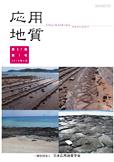All issues

Volume 57, Issue 1
Displaying 1-2 of 2 articles from this issue
- |<
- <
- 1
- >
- >|
Original Article
-
Yukiko KUSANO, Koichi SUZUKI, Tomochika TOKUNAGA2016Volume 57Issue 1 Pages 2-14
Published: April 10, 2016
Released on J-STAGE: June 04, 2016
JOURNAL FREE ACCESSElectromagnetic exploration using the CSAMT method was conducted to reveal the distribution of saltwater and freshwater beneath the Nakano-shima Island, Oki-Dozen, which is located on a continental shelf. For better interpreting the resistivity structure in the Island, rock samples obtained from the Island were used to measure bulk resistivities as a function of the salinity of pore water. Existence of inferred fault which formed depression structure is suggested by previous studies. Contrast of resistivity distribution found from measurement points which across the inferred fault was interpreted as difference of geological structure bounded by the fault. The resistivity distributions in depression showed the higher resistivity zone from surface to about -100m elevation, the lower resistivity zone in between -100 and -200m elevation, the higher resistivity zone below, and the lower resistivity zone further below, i.e., the existence of four distinct resistivity zones. Each zone was interpreted, as descending order, modern fresh groundwater, groundwater with higher salinity, fresh groundwater recharged in colder climate, and groundwater with higher salinity.View full abstractDownload PDF (3900K) -
Ryuta HATAYA, Makoto YANAGIDA, Yuji TORIGOE, Masaru SATO2016Volume 57Issue 1 Pages 15-26
Published: April 10, 2016
Released on J-STAGE: June 04, 2016
JOURNAL FREE ACCESSWe did the risk analysis of the downward erosion of about future 100,000 years for geological disposal. We have investigated the base of the alluvium in Japan. The depth of alluvium is a good indicator of the downward erosion caused by both river process and sea-level change. On the basis of these data, we showed the relationship between the maximum depth of downward erosion near the recent shoreline since Late Pleistocene (y) and the uplift from Late Pleistocene to the recent (x) in the uplift areas are as follows: y≧-x-100.Based on the uniformitarian view, we can estimate the maximum depth of downward erosion of the future in the uplift area using the above relationship. However, evaluation of subsidence areas is a future challenge.View full abstractDownload PDF (1714K)
- |<
- <
- 1
- >
- >|